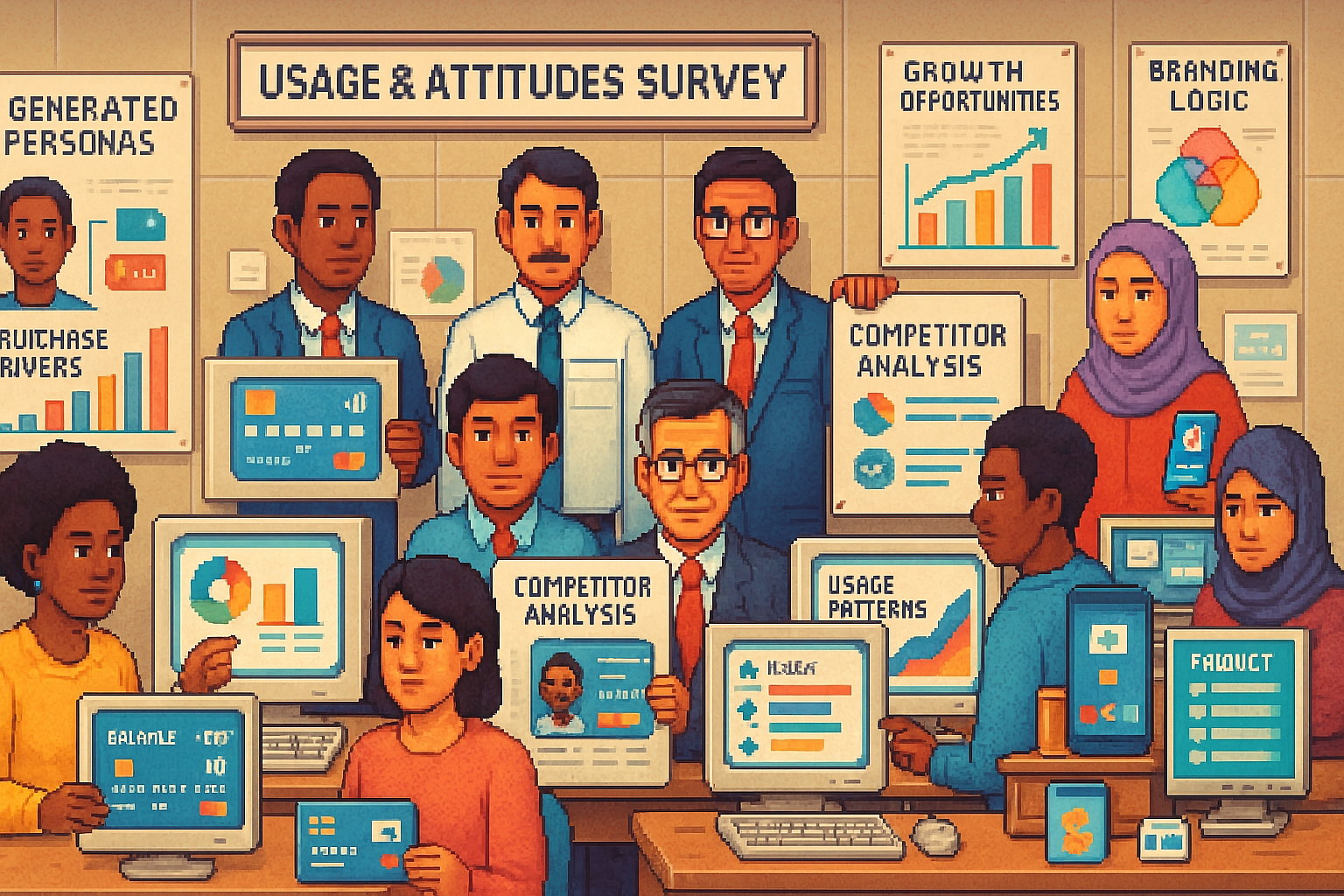Usage & Attitudes
Understand your market at the deepest level using AI personas in a comprehensive Usage & Attitudes survey. This synthetic research approach reveals who uses your product, how they use it, why they choose it, and what drives their purchase decisions. Get detailed insights into consumer behavior patterns, brand perceptions, and market opportunities without the complexity of recruiting hundreds of real respondents across multiple demographics.

What is it Used For?
Usage & Attitudes surveys provide foundational market understanding by mapping consumer behavior patterns, attitudes, and preferences within your category. This market research methodology helps businesses identify growth opportunities by understanding who uses what products, how often, when, where, and why. The research reveals purchase drivers and barriers, uncovers underserved market segments, measures brand awareness and perception against competitors, tracks changes in consumer behavior over time, and segments markets based on usage patterns and attitudes. Usage & Attitudes studies work particularly well for understanding complex product categories, identifying new target audiences, optimizing marketing messages, and making strategic decisions about product development or market expansion. The methodology combines behavioral data about what people do with attitudinal data about what they think and feel.
Real-World Example
I was working with a major fintech client through Ladder who had built a comprehensive financial app with multiple features. They offered bill splitting with friends, cheap foreign exchange rates, and current accounts designed for couples. Each feature attracted completely different types of users, but we weren't sure which segments had the highest purchase intent.
The challenge was that we were spending $1,000 daily on Facebook ads with mediocre results. We knew we had valuable features, but our targeting was too broad. We were essentially throwing money at everyone instead of focusing on the people most likely to convert.
We decided to run a comprehensive Usage & Attitudes study to understand purchase intent drivers across different customer segments. We surveyed people about their financial habits, which features they valued most, and what would drive them to sign up for a new financial app.
The results were eye-opening. We discovered distinct clusters of users who valued completely different aspects of the product. The bill-splitting audience was primarily younger, social users who frequently dined out and traveled with friends. The foreign exchange users were often business travelers or people with international connections. The couples' account users were typically in committed relationships looking to simplify shared expenses.
More importantly, each segment had different purchase intent drivers. What motivated someone to sign up wasn't just the features they liked, but how those features fit into their existing financial behaviors and pain points.
We used these insights to completely restructure our creative strategy and audience targeting. Instead of generic ads highlighting all features, we created segment-specific campaigns that spoke directly to each group's motivations and usage patterns.
The results were immediate and dramatic. We scaled our Facebook ad spend from $1,000 to $20,000 daily while maintaining strong conversion rates. By targeting the right segments with the right message, we found our product-market fit at scale.
How to Conduct This Research in Ask Rally
Step 1: Define Your Research Scope
Start by clarifying what you want to understand about your market. Focus on specific business questions rather than trying to measure everything. Consider usage patterns, purchase drivers, brand perceptions, or competitive dynamics.
Step 2: Generate Representative Personas
Create AI personas that reflect your target market's diversity. Include demographic variation, behavioral differences, usage frequency levels, and attitudinal segments. For comprehensive market mapping, generate 500-1000 personas across different segments.
Step 3: Map the Customer Journey
Structure questions around the entire customer experience from awareness to advocacy. Cover brand awareness, consideration factors, usage occasions, satisfaction levels, and loyalty drivers.
Step 4: Identify Usage Patterns
Ask about frequency, context, and motivations for product usage. Understand when, where, how, and why people use products in your category. Look for different usage occasions and needs.
Step 5: Measure Attitudes and Perceptions
Explore brand perceptions, feature preferences, purchase drivers, and barriers to adoption. Include both rational and emotional factors that influence decision-making.
Step 6: Segment by Behavior and Attitudes
Analyze responses to identify distinct market segments based on usage patterns, preferences, and attitudes. Look for segments that behave differently or value different product attributes.
Step 7: Connect Attitudes to Purchase Intent
Link attitudinal measures to behavioral outcomes like purchase intent, brand switching, or recommendation likelihood. Identify which attitudes are strongest predictors of valuable behaviors.
Step 8: Validate Insights with Follow-up Research
Use your U&A findings to design targeted validation studies with smaller samples of real customers in your highest-opportunity segments.
Starter Prompt Template
Use this prompt template to get started with usage & attitudes in Ask Rally:
Stay Updated
Subscribe to our newsletter to get notified about new articles and updates.
